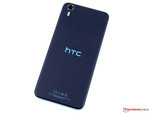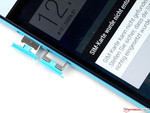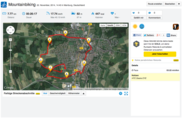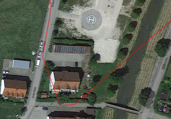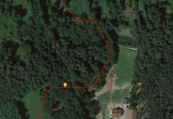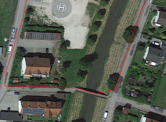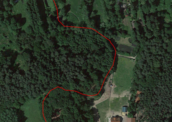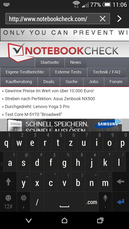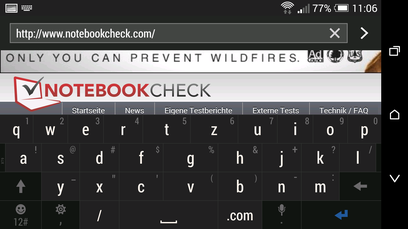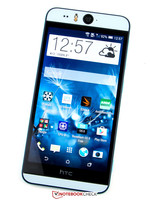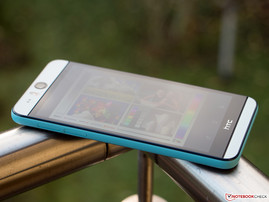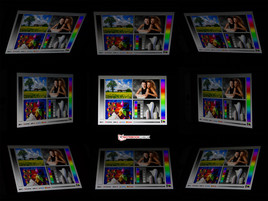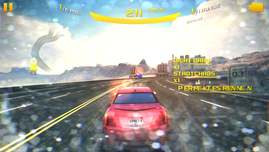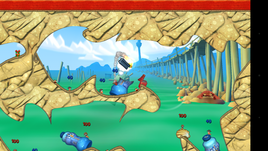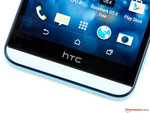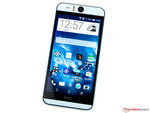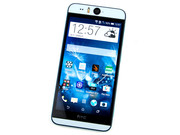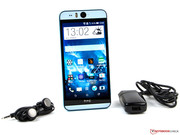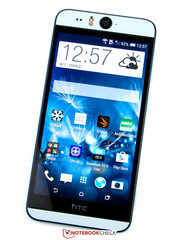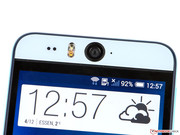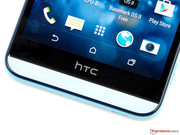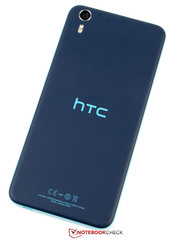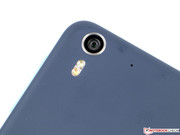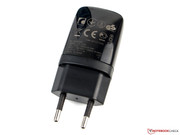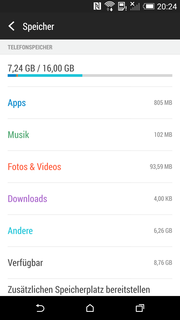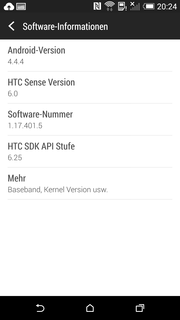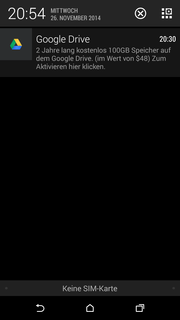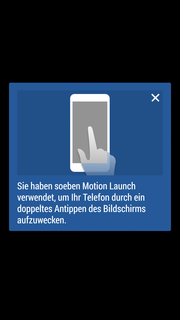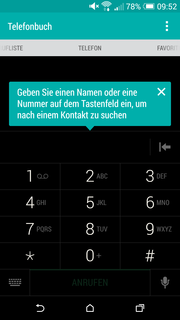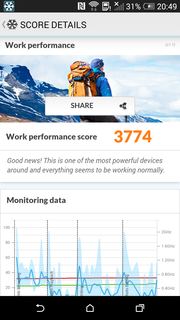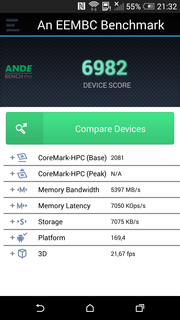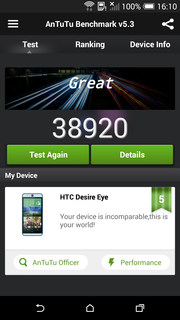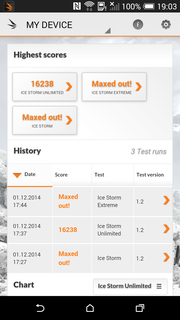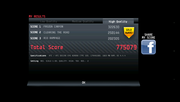HTC Desire Eye Smartphone Review

For the original German review, see here.
It was usually the low-resolution cameras that gave reason for complaint in HTC's One M8. The Taiwanese phone-builder now wants to teach their competitors a lesson with the HTC Desire Eye and installs a 13 MP lens and dual-LED flash in both the primary camera on the back as well as the front-facing camera.
The configuration is very impressive otherwise. A speedy Snapdragon 801 ensures plenty of computing power, and the 2 GB of working memory is adequately dimensioned. The 16 GB internal storage can be expanded via a micro-SD, and the Full HD screen has a size of 5.2-inches. However, the smartphone is not clad in aluminum, and thus the buyer has to be satisfied with plastic. A larger battery could also have been used; it has an average capacity of 2400 mAh.
Its configuration and an RRP of 529 Euros (~$658) places HTC's Desire Eye in the premium range, and it faces strong rivals. In addition to the in-house One M8 and One E8 models, top-of-the-line products like Samsung's Galaxy S5, Sony's Xperia Z3, Apple's iPhone 6, LG's G3, and Nokia's Lumia 930 step in line.
Case
HTC's Desire Eye is made completely of plastic and is available in the colors "Submarine Blue" and "Coral Red." The handheld is quite big and weighs 154 grams. It is comfortable to hold without feeling too heavy. Pleasing: the phone is IPX7 certified and is thus dust-proof and can be submerged in water up to a depth of one meter for a maximum of thirty minutes.
The casing produced a cracking noise in our warping attempts, but the smartphone proved quite rigid and always returned to its original state. The gaps are very even and flush. The user does not need to worry that too much dirt will accumulate here. Besides that, the Eye is not particularly pressure sensitive. High force on the back is needed to form light waves on the screen.
The slots for the cards are a bit awkward, but that is tolerable since they must be waterproof. The battery is non-removable and cannot be replaced.
Connectivity
The micro-USB 2.0 port of HTC's Desire Eye can be used for both recharging the smartphone as well as sharing data with a computer. OTG is supported so that connecting an external input device or USB flash drive is no problem. The interface is not MHL capable, though.
Memory cards with a capacity of 128 GB can be inserted into the micro-SD card reader. Unfortunately, App2SD is not supported and apps have to be installed on the handheld and opened from there. However, temporary Internet files, notifications, as well as image and audio recordings can be directly stored on an optional SD card.
Software
Google's Android 4.4.4 KitKat operating system is preloaded on HTC's Desire Eye and is covered with the proprietary HTC Sense. An in-depth insight can be found in the review of HTC's One M8. The manufacturer has announced an update to Google's latest Android 5.0 Lollipop for the first quarter 2015.
Apart from a few in-house apps, there is no third-party software on the handheld. A Kids Mode is also preloaded. Power To Give "donates" unused processing power of the Eye for scientific projects. It makes idle resources available for pre-selected projects as soon as the device is connected to a Wi-Fi network and is recharging.
Communication & GPS
HTC's Desire Eye has a Wi-Fi module that supports the IEEE 802.11 a/b/g/n standards and can thus operate in the 2.4 and 5.0 GHz frequency ranges. The latest ac standard is not supported, which is a weak performance in view of the top-of-the-line placement. The range is quite good, though. Even 20 meters away from the router (Fritz!Box 6360, 2.4 GHz band), the handheld displayed an average signal. However, websites needed noticeably longer to open.
In addition to NFC, Bluetooth 4.0 is also installed. The connection proved stable when streaming HD content alongside audio output via an external speaker and did not give reason for complaint.
Internet on-the-move is possible either via HSPA+ or high-speed LTE Cat. 4 (max. 150 Mbps downstream). The manufacturer, however, clearly prefers the newer standard. Only few HSPA+ frequency ranges are covered, but they are absolutely sufficient for Central Europe.
Localization is possible via GPS and Glonass. This functioned very fast outdoors. It took only a moment longer until we could link to a satellite network indoors. However, even a small shelter managed to disconnect an existing connection and sometimes a fast movement was enough to lose the signal.
We compared the positioning accuracy of HTC's Desire Eye with the Garmin Edge 500 bike computer. The smartphone was not able to track the route properly, and it simply lost us in the woods. The review sample has a total deviation of approximately 6% compared with the Garmin navigation system. That is a middling result; most rivals do a better job.
Telephone & Voice Quality
The same phone app as in the bigger One M8 is used. It makes a very well-conceived impression and is functional.
The voice quality of HTC's Desire Eye is decent. We heard our call partner loud and clear when held to the ear. The audio quality was impeccable on the other side and made a superb impression. The speaker sounds a bit piercing in high pitches, but it does its job well otherwise. It is a good alternative in quiet surroundings when the hands-free mode has to be used. Although the included headset is useful, it is definitely not a long-term solution. On the one hand, it is very bass-heavy and on the other hand, calls are accompanied by an incessant noise.
Cameras
The difference between both cameras in HTC's Desire Eye is found in details. The rear-facing lens is capable of up to 13.1 MP (4208x3120 pixels; 4:3). The user will have to be satisfied with approximately 10 MP (4208x2368 pixels) when shots are to be taken in 16:9. The back-side illuminated sensor (BSI) operates with an aperture of f/2.0. The focal length corresponds to a 28 mm wide angle. The pictures are sharp and display good color accuracy. However, the lens tends to overexpose bright areas slightly. The low-light properties of the Desire Eye are not breathtaking despite the BSI sensor. Noise quickly arises in poor light and the outlines look frayed. The dual-LED flash counters this effect well and the colors remain quite natural.
The front-facing camera also features 13.1 MP, a BSI sensor with auto focus, and a dual-LED flash. However, its aperture of f/2.2 is a bit smaller. In return, the 22 mm wide angle can capture more people on a picture. In fact, the camera presents quite decent results. It is currently the highest-resolution front lens in a smartphone and can take advantage of this. The Ascend P7 (8MP) comes closest to this unit, and otherwise some devices with 5 MP cameras are found in the market. The quality of the lens in HTC's Desire Eye is also compelling and will absolutely satisfy selfie fans. Although the color accuracy could be a bit better, the focus is really good.
The cameras thus do a decent job. However, not only the picture quality is good, but also the diversity of features is impressive. There are 16 different filters that can be used while taking shots, and HTC has not neglected post-production, either. The picture modes cover everything that might be wanted and offer different panorama options, motive shots, an automatic passport mode and split images that allows combining pictures from both cameras, just to name a few.
Both lenses can shoot videos in Full HD. Again, multiple modes are available here. It is possible to use the cameras simultaneously. Sound is recorded in stereo that is, however, only weakly audible and accompanied by background noise in quiet surroundings.
Accessories
The included accessories for HTC's Desire Eye are comprised of a modular power supply with an output of 5 watts (5 volts, 1 ampere), a headset, and a USB cable.
HTC optionally has better headsets and external speakers on its website (German). The Dot View Cover (German) (40 Euros, ~$49) is also compatible with the smartphone.
Warranty
HTC includes a non-extendable 24-month warranty on its product.
Input Devices & Controls
The capacitive touchscreen of HTC's Desire Eye has a sleek surface that is convincing. The accuracy is very good, and inputs are implemented quickly and precisely.
The virtual keyboard is very well-conceived but makes a slightly unclear impression the first time it is used. Inputting via swipe gestures is also supported. An additional row with automatic word suggestions is also available.
The physical keys feature a short drop and clear pressure point. Only the camera button makes a slightly spongy impression in the first setting, and its release point is a bit sticky.
Display
Unlike the One M8 (SuperLCD 3), HTC's Desire Eye uses an IPS screen with a diagonal of 5.2-inches, which is until now HTC's biggest premium-range phone. It has a resolution of 1920x1080 pixels and an aspect ratio of 16:9, as well as a superb pixel density of 424 ppi so that the image is razor-sharp.
The manufacturer has greatly increased the brightness. The Eye achieves an outstanding 655 cd/m², which even outshines the One M8 (max. 508 cd/m²; 93%) or the iPhone 6 (max. 529 cd/m²; 88%). Only Sony's Xperia Z3 (max. 702 cd/m²; 90%) is even brighter. The illumination of 92% is very homogeneous. A minor shortcoming is the faint halo in the lower right corner, which only became visible on a completely black background.
| |||||||||||||||||||||||||
Brightness Distribution: 92 %
Center on Battery: 635 cd/m²
Contrast: 1176:1 (Black: 0.54 cd/m²)
ΔE Color 4.11 | 0.5-29.43 Ø5
ΔE Greyscale 4.29 | 0.57-98 Ø5.3
Gamma: 2.59
| HTC Desire EYE Adreno 330, 801 MSM8974AB, 16 GB eMMC Flash | HTC One M8 Adreno 330, 801 MSM8974AB, 16 GB iNAND Flash | Samsung Galaxy S5 Adreno 330, 801 MSM8974AC, 16 GB eMMC Flash | Huawei Ascend P7 Mali-450 MP4, Kirin 910T, 16 GB eMMC Flash | Nokia Lumia 930 Adreno 330, 800 MSM8974, 32 GB eMMC Flash | |
|---|---|---|---|---|---|
| Screen | -19% | -27% | -24% | -75% | |
| Brightness middle | 635 | 474 -25% | 358 -44% | 464 -27% | 275 -57% |
| Brightness | 631 | 486 -23% | 364 -42% | 470 -26% | 278 -56% |
| Brightness Distribution | 92 | 93 1% | 82 -11% | 92 0% | 89 -3% |
| Black Level * | 0.54 | 0.54 -0% | 0.92 -70% | ||
| Contrast | 1176 | 878 -25% | 504 -57% | ||
| Colorchecker dE 2000 * | 4.11 | 5.86 -43% | 5.28 -28% | 4.18 -2% | 10.99 -167% |
| Greyscale dE 2000 * | 4.29 | 5.2 -21% | 4.65 -8% | 3.71 14% | 8.29 -93% |
| Gamma | 2.59 85% | 2.29 96% | 2.48 89% | 2.48 89% | 2.16 102% |
| CCT | 6956 93% | 7218 90% | 7690 85% | 6441 101% | 6731 97% |
* ... smaller is better
The black level does not suffer under the improved brightness of HTC's Desire Eye and achieves a decent rate of 0.54 cd/m². That is ultimately the shortcoming of the brighter Xperia Z3 (0.72 cd/m²; 975:1), which has a slightly increased black level. The resulting contrast of 1716:1 in the Desire is absolutely top for an IPS screen and is only surpassed by the OLEDs in the comparison field.
The review sample's color reproduction is also really good, and we can only complain on a high level. The colors barely deviate; only a marginal shift towards green is seen in the grayscale in the white values. Besides that, primarily green is slightly over-saturated. This will, however, not be noticed adversely in practice.
HTC's Desire Eye is convincing in outdoor use owing to its high brightness and very good contrast ratio. There are virtually no noticeable restrictions in cloudy conditions. It might only be strenuous to look at the screen over a longer period in bright sunlight, but the Desire Eye is also superior to many contenders despite its glossy surface here.
The viewing-angle stability is also very good. The IPS screen does not have problems displaying images even in acute viewing angles. We did not ascertain a glow or a ghost effect. Only the brightness starts to decrease slightly from an angle of approximately 40 degrees.
Performance
HTC's Desire Eye is equipped with a Qualcomm Snapdragon 801 MSM8974AB. The quad-core SoC clocks with 2.3 GHz each and is supported by 2 GB of working memory. The Qualcomm Adreno 330 is responsible for graphics calculations. The SoC promises plenty of power and also proves that in practice.
The system delivers the expected scores in the benchmarks and is roughly on par with the rivals that are based on the same SoC. The AC version of the Snapdragon 801 is even slightly faster, but the available performance is absolutely sufficient and ensures a smooth system performance and fast opening apps under Android.
We ascertained an impressive browser performance using the stock browser. Internet browsing is swift, as reflected in the benchmarks.
The storage of 16 GB is actually sufficiently sized, but the user only has 8.8 GB available after initial use. Although it can be expanded by up to 128 GB, the lack of App2SD support might become tight quite soon, especially for gamers.
However, the flash storage's speed is really good and can outrun most of its rivals. LG's G3 and the Galaxy Note 4, however, remain to be the measure of things.
| Geekbench 3 | |
| 32 Bit Single-Core Score (sort by value) | |
| HTC Desire EYE | |
| Huawei Ascend P7 | |
| HTC One M8 | |
| HTC One E8 | |
| LG G3 | |
| Sony Xperia Z3 | |
| Samsung Galaxy S5 | |
| Apple iPhone 6 | |
| 32 Bit Multi-Core Score (sort by value) | |
| HTC Desire EYE | |
| Huawei Ascend P7 | |
| HTC One M8 | |
| HTC One E8 | |
| LG G3 | |
| Sony Xperia Z3 | |
| Samsung Galaxy S5 | |
| Apple iPhone 6 | |
| GFXBench 3.0 | |
| on screen Manhattan Onscreen OGL (sort by value) | |
| HTC Desire EYE | |
| HTC One M8 | |
| HTC One E8 | |
| LG G3 | |
| Sony Xperia Z3 | |
| Samsung Galaxy S5 | |
| Apple iPhone 6 | |
| 1920x1080 1080p Manhattan Offscreen (sort by value) | |
| HTC Desire EYE | |
| HTC One M8 | |
| HTC One E8 | |
| LG G3 | |
| Sony Xperia Z3 | |
| Samsung Galaxy S5 | |
| Apple iPhone 6 | |
| 3DMark | |
| 1280x720 offscreen Ice Storm Unlimited Score (sort by value) | |
| HTC Desire EYE | |
| Huawei Ascend P7 | |
| HTC One M8 | |
| HTC One E8 | |
| LG G3 | |
| Sony Xperia Z3 | |
| Samsung Galaxy S5 | |
| Apple iPhone 6 | |
| 1280x720 offscreen Ice Storm Unlimited Graphics Score (sort by value) | |
| HTC Desire EYE | |
| Huawei Ascend P7 | |
| HTC One M8 | |
| HTC One E8 | |
| LG G3 | |
| Sony Xperia Z3 | |
| Samsung Galaxy S5 | |
| Apple iPhone 6 | |
| 1280x720 offscreen Ice Storm Unlimited Physics (sort by value) | |
| HTC Desire EYE | |
| Huawei Ascend P7 | |
| HTC One M8 | |
| HTC One E8 | |
| LG G3 | |
| Sony Xperia Z3 | |
| Samsung Galaxy S5 | |
| Apple iPhone 6 | |
| Peacekeeper - --- (sort by value) | |
| HTC Desire EYE | |
| Huawei Ascend P7 | |
| Nokia Lumia 930 | |
| HTC One M8 | |
| LG G3 | |
| Sony Xperia Z3 | |
| Samsung Galaxy S5 | |
| Apple iPhone 6 | |
| Octane V2 - Total Score (sort by value) | |
| HTC Desire EYE | |
| Huawei Ascend P7 | |
| Nokia Lumia 930 | |
| HTC One M8 | |
| HTC One E8 | |
| LG G3 | |
| LG G3 | |
| Sony Xperia Z3 | |
| Samsung Galaxy S5 | |
| Apple iPhone 6 | |
| Sunspider - 1.0 Total Score (sort by value) | |
| HTC Desire EYE | |
| Huawei Ascend P7 | |
| Nokia Lumia 930 | |
| HTC One M8 | |
| HTC One E8 | |
| LG G3 | |
| LG G3 | |
| Sony Xperia Z3 | |
| Samsung Galaxy S5 | |
| Apple iPhone 6 | |
* ... smaller is better
Games
A large screen, a high resolution, and great speakers ensure plenty of gaming fun with HTC's Desire Eye. The Adreno 330 supports all common graphics interfaces and also still offers enough power for upcoming titles. There is currently no game in the Play Store that pushes the GPU to its limits. Both graphically demanding games, like Asphalt 8, and classics, like Worms 3, run smoothly.
The decent touchscreen and impeccably functioning sensors never ruin the entertainment and do not give reason for complaint.
Emissions
System Noise
The surface temperatures of HTC's Desire Eye achieved a maximum idle of 30.6 °C. The rates climbed up to 35.9 °C under load that we simulated with the Stability Test app. Those are superb rates. The review sample is thus the coolest handheld in the comparison field. The iPhone 6 (max. 43.6 °C) presents the highest temperatures.
We checked the performance stability under permanent load with the Battery Test of GFXBench 3.0. The T-Rex benchmark is run thirty times in succession, and both the battery state and the frame rates are recorded. The performance of the Desire Eye already decreases after about four runs and ultimately settles to approximately 80% of the initial performance. This throttling is frequently observed in strong SoCs.
(+) The maximum temperature on the upper side is 35.9 °C / 97 F, compared to the average of 35 °C / 95 F, ranging from 21.9 to 56 °C for the class Smartphone.
(+) The bottom heats up to a maximum of 35.8 °C / 96 F, compared to the average of 33.8 °C / 93 F
(+) In idle usage, the average temperature for the upper side is 27.4 °C / 81 F, compared to the device average of 32.7 °C / 91 F.
Speakers
HTC's Desire Eye has two speakers located on the sides of the screen when held in landscape mode. The stereo speakers feature HTC's BoomSound and are compelling. The sound is quite balanced and only gets a bit tinny in maximum volume. The components do a very good job particularly in games and videos.
The included headset is very bass-heavy and the trebles are a bit flat. All in all, they are nevertheless members of the better, included headsets.
Energy Management
Power Consumption
The power consumption of HTC's Desire Eye does not display either positive or negative surprises. It is thus on a similar level as the contenders. The idle consumption ranges from 0.3 to 1.5 watts, and the rates climb up to 6.2 watts during load. The slightly higher consumption rate compared with the M8 is due to the larger screen.
However, the power supply's nominal capacity of 5 watts is too tight. That will noticeably increase the 3 hours normally needed for recharging during full load.
| Off / Standby | |
| Idle | |
| Load |
|
Battery Runtime
The non-removable battery of HTC's Desire Eye has a capacity of 2400 mAh. It is smaller than those found in other flagship smartphones, such as HTC's One M8 (2900 mAh) or Samsung's Galaxy S5 (2800 mAh). Nevertheless, the review sample achieves good runtimes and even defeats its bigger aluminum brother in all sectors. Only the S5 presents better results in total.
The best possible comparison is achieved by using a screen brightness of 150 cd/m². All consumers, except for the Wi-Fi connection, are disabled in the Wi-Fi browsing test. A script that loads a new website every 40 seconds is opened. The Desire lasted for over 15 hours here. That is an excellent rate, which is only surpassed by the Lumia 930. The Eye achieves great results in the other tests, as well. The video playback time was astonishingly low because Android devices normally last longer in this test than in the Wi-Fi test.
| HTC Desire EYE Adreno 330, 801 MSM8974AB, 16 GB eMMC Flash | HTC One M8 Adreno 330, 801 MSM8974AB, 16 GB iNAND Flash | Samsung Galaxy S5 Adreno 330, 801 MSM8974AC, 16 GB eMMC Flash | Huawei Ascend P7 Mali-450 MP4, Kirin 910T, 16 GB eMMC Flash | Sony Xperia Z3 Adreno 330, 801 MSM8974AC, 16 GB eMMC Flash | Nokia Lumia 930 Adreno 330, 800 MSM8974, 32 GB eMMC Flash | |
|---|---|---|---|---|---|---|
| Battery Runtime | -41% | 6% | -19% | -10% | -2% | |
| Reader / Idle | 1433 | 863 -40% | 1695 18% | 963 -33% | 1203 -16% | 1387 -3% |
| H.264 | 503 | 385 -23% | 556 11% | 682 36% | ||
| WiFi | 914 | 453 -50% | 613 -33% | 574 -37% | 672 -26% | 1002 10% |
| Load | 200 | 102 -49% | 253 27% | 228 14% | 132 -34% | 175 -12% |
Verdict
HTC's Desire Eye is yet another flagship smartphone that is not clad in elegant aluminum. However, it features an IP certification for the first time making it dust and waterproof. The selfie handheld thus not only shoots decent pictures in every situation and under adverse conditions, it also meets the demands of hardware buffs.
A very swift SoC in the form of the Snapdragon 801 is integrated, which ensures smooth utilization of Google's Android 4.4 KitKat. An update to Lollipop is also in the works. High-speed LTE is also installed, though not in the latest version. Besides that, we miss the latest ac Wi-Fi standard. The GPS antennas additionally sometimes lose the network connection, which leads to a somewhat inaccurate localization. Furthermore, the available storage capacity is a bit tight.
Despite that, the review sample shines with powerful speakers, a good voice quality, and long runtimes. Users who like selfies and groufies will hardly get around HTC's Desire Eye.


 Deutsch
Deutsch English
English Español
Español Français
Français Italiano
Italiano Nederlands
Nederlands Polski
Polski Português
Português Русский
Русский Türkçe
Türkçe Svenska
Svenska Chinese
Chinese Magyar
Magyar